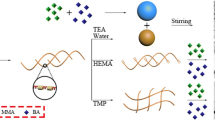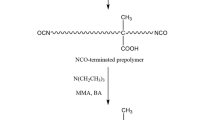Abstract
Hydrophobically modified alkali-soluble emulsion (HASE) polymers are an important class of rheology modifiers for waterborne coatings applications. They are typically prepared as terpolymers by emulsion polymerization of ethyl acrylate (EA), methacrylic acid (MAA), and an associative macromonomer. The viscosity development and shear responses of HASE solutions depend on a number of factors. This article presents rheological data reflecting the impacts of three key variables: hydrophobe size, acid content, and molecular weight, on model HASE thickening and rheological performance. The relative contributions of hydrophobic association, chain expansion, and polymer chain length are discussed.
In steady shear flow, all thickener solutions approached some constant low-shear viscosity at small deformation rates. At the same molar composition, larger hydrophobe size resulted in higher viscosity development and greater shear thinning behavior.
The amount of acid monomer in HASE polymers can influence the balance between hydrophobic attraction and electrostatic repulsion forces. It was found that a minimum of 15 wt% MAA was required to effect dissolution and thickening of the model HASE polymers. Increasing the MAA level yielded higher zero-shear viscosity and storage modulus G’ with maximal values being obtained at 40% MAA.
The molecular weight of the model thickeners was controlled by the amount of chain transfer agent (CTA) added during polymerization. When the CTA level was below 0.1 wt% based on total monomers, the polymer solutions displayed shear-thinning behavior. A small increase in CTA concentration beyond 0.1% resulted in a dramatic change to Newtonian flow, and the solution viscosity was nearly two orders of magnitude lower.
The model thickeners were also tested in a vinyl acrylic architectural paint formulation. The effects of each individual factor on paint thickener efficiency, high-shear, and low-shear properties are discussed and compared with solution rheology for predictive relationships.
Similar content being viewed by others
References
Siddiq, M., Tam, K.C., and Jenkins, R.D., “Dissolution Behavior of Model Alkali-Soluble Emulsion Polymers: Effects of Molecular Weight and Ionic Strength,”Conlloid Polym. Sci., 277, 1172–1178 (1999).
Kumacheva, E., Rharbi, Y., Winnik, M.A., Guo, L., Tam, K.C., and Jenkins, R.D., “Fluorescence Studies of an Alkali-Swellable Associative Polymer in Aqueous Solution,”Langmuir, 13, 182 (1997).
Horiuchi, K., Rharbi, Y., Yekta, A., Winnik, M.A., Jenkins, R.D., and Bassett, D.R., “Dissolution Behavior in Water of a Model Hydrophobic Alkali-Swellable Emulsion (HASE) Polymer with C20H41 Groups,”Can. J. Chem., 76, 1779–1787 (1998).
Wang, C., Tam, K.C., Jenkins, R.D., and Bassett, D.R., “Potentiometric Titration and Dynamic Light Scattering of Hydrophobically Modified Alkali Soluble Emulsion (HASE) Polymer Solutions,”Chem. Phys., 2, 1967–1972 (2000).
Wang, C., Tam, K.C., and Jenkins, R.D., “Dissolution Behavior of HASE Polymers in the Presence of Salt: Potentiometric Titration, Isothermal Titration Calorimetry, and Light Scattering Studies,”J. Phys. Chem. B, 106, 1195–1204 (2002).
Knaebel, A., Skouri, R., Munch, J.P., and Candau, S.J., “Structural and Rheological Properties of Hydrophobically Modified Alkali-Soluble Emulsion Solutions,”J. Polym. Sci. Part B: Polym. Phys., 40, 1985–1994 (2002).
English, R.J., Gulati, H.S., Jenkins, R.D., and Khan, S.A., “Solution Rheology of a Hydrophobically Modified Alkali-Soluble Associative Polymer,”J. Rheol., 41(2), 427–444 (1997).
Hoy, K.L. and Hoy, R.C., “Polymer with Hydrophobe Bunches,” U.S. Patent 4,426,485.
Jenkins, R.D., Delong, L.M., and Bassett, D.R., “Influence of Alkali-Soluble Associative Emulsion Polymer Architecture on Rheology,” inHydrophilic Polymers: Performance with Environmental Acceptability, Glass, J.E. (Ed.), ACS Symposium Series No. 248, American Chemical Society, Washington, D.C., Chap. 23, 1996.
Bassett, D.R., Jenkins, R.D., and Shay, G.D., “Aqueous Latexes Containing Macromonomers,” U.S. Patent 5,486,587.
Tanford, C.,The Hydrophobic Effect: Formation of Micelles and Biological Membranes, John Wiley & Sons, New York, NY, 1980.
Jenkins, R.D., “The Fundamental Thickening Mechanism of Associative Polymers: A Rheological Study,” Ph.D. Thesis, Lehigh University, Bethlehem, PA, 1990.
Tanaka, F. and Edwards, S.F., “Viscoelastic Properties of Physically Crosslinked Networks (Parts 1, 2, and 3),”J. Non-Newtonian fluid Mech., 43, 247–272, 273–288, and 289–309 (1992).
Annable, T., Buscall, R., Ettelaie, R., and Whittlestone, D., “The Rheology of Solutions of Associating Polymers: Comparison of Experimental Behavior with Transient Network Theory,”J. Rheol. 37, 695–726 (1993).
Hildebrand, J.H. and Scott, R.L.,The Solubility of Non-electrolytes, Dover Publication, Inc., New York, NY, p. 253, 1964.
Tirtaamadja, V., Tam, K.C., and Jenkins, R.D., “Rheological Properties of Model Alkali-Soluble Associative (HASE) Polymers: Effect of Varying Hydrophobe Chain Length,”Macromolecules, 30, 3271–3282 (1997).
Wu, W., Grieb, R.S., and Shay, G.D., “Rheological Characterization of Model HASE Thickners,” inProc. 29th International Waterborne, High-Solids, and Powder Coatings Symp., New Orleans, LA, 343–355, 2002.
Bird, R.B., Armstrong, R.C., and Hassager, O.,Dynamics of Polymer Liquids, Vol. 1: Fluid Mechanics, Wiley, New York, NY, 1987.
Darby, R.,Viscoelastic Fluids: An Introduction to Their Properties and behavior, Marcel Dekker, New York, NY, 1976.
Shay, G.D., Bassett, D.R., and Rex, J.D., “A New Class of Alkali-Swellable Associative Thickners,”Surf. Coat. Intern., November, 446–453 (1993).
Shay, G.D., “Flow Control with HEURASE Rheology Modifiers,”APCJ, December 20, 44–53 (1993).
Gambino, J.J. and Schaller, E.J., “Rheology Modifiers For Latex Paints,”Mod. Paint Coat., July, 36–40 (1982).
Schoff, C.K.Rheology, Federation Series on Coatings Technology, Federation of Societies of Coatings Technology, Blue Bell, PA, 1991.
Shay, G.D. and Rich, A.F., “Urethane-Functional Alkali-Soluble Associative Latex Thickeners,”Journal of Coatings Technology, 58, No. 732, 43 (1986).
Shay, G.D., “Alkali-Swellable and Alkali-Soluble Thickener Technology: A Review,” inPolymers in Aqueous Media, Performance Through Association, Glass, J.E. (Ed.), Advances in Chemistry Series 223, American Chemical Society, Washington, D.C., 457–494 1989.
Toshio, M., Fernando, R.J., and Glass, J.E., “The Influence of Hydrophobically-Modified, Alkali-Swellable Emulsions on the Rheology of Pigmented coatings,”Surf. Coat. Intern., 76 (1), 8 (1993).
Glass, J.E., “Influence of Water-Soluble Polymers on Rheology of Pigmented Latex Coatings,” inWater-Soluble Polymers, Beauty with Performance, Glass, J.E. (Ed.), Advances in Chemistry Series 213, American Chemical Society, Philadelphia, PA, 391–416, 1984.
Tirtaamadja, V., Tam, K.C., and Jenkins, R.D., “Superposition of Oscillations on Steady Shear Flow as a Technique for Investigating, the Structure of Associative Polymers,”Macromolecules, 30, 1426–1433 (1997).
Brown, G. and Chakrabarti, A., “Structure Formation in Self-Associating Polymer and Surfactant Systems,”J. Chem. Phys., 96, 3251 (1992).
Howard, P.R., Leasure, E.L., Rosier, S.T., and Schaller, E.J., “Systems Approach to Rheology Control,” inPolymers as Rheology Modifiers, Glass, E.J. (Ed.), ACS Symposium Series 462, American Chemical Society, Washington, D.C., 211, 1992.
Graessley, W.W., “The Entanglement Concept in Polymer Rheology,”Adv. Polym. Chem. 17, 19–151 (1974).
Aubry, T. and Moan, M., “Rheological Behavior of a Hydrophobically Associating Polymer Solutions,”J. Rheol. 38, 1681–1692 (1994).
Leibler, L., Rubinstein, M., and Colby, R.H., “Dynamics of Reversible Networks,”Macromolecules, 24, 4701–4707 (1991).
Author information
Authors and Affiliations
Rights and permissions
About this article
Cite this article
Wu, W., Shay, G.D. Tailoring HASE rheology through polymer design: Effects of hydrophobe size, acid content, and molecular weight. J Coat Technol Res 2, 423–433 (2005). https://doi.org/10.1007/BF02733885
Issue Date:
DOI: https://doi.org/10.1007/BF02733885




